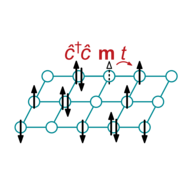
Open projects for students
We are always looking for motivated students to join our group. If you are looking for a Bachelor's or Master's thesis in the field of Computational Condensed Matter Theory, please contact Prof. F. Evers or Dr. J. Wilhelm. Please find exemplary projects below.
Master Thesis on Molecular Machines
A molecular machine is a large molecule that undergoes a (directed) rotation when an electric current flows through. A candidate molecule for such a device is a helix as sketched below. Helical molecules can nowadays be synthesized in the laboratory [1]. Within a classical picture the directionality of the rotation results from angular momentum conservation.
In this Master project, we propose to calculate how the electric current flows through such helical molecules. To this end, the inhouse transport software package aitranss [2-3] will be equipped with a fresh module to calculate the current density, j(r). Resorting to an argument from classical mechanics, the mechanical torque exerted on the molecule by the current flow will be accessible. As an application, we propose to study effects of the precise molecular geometry on the angular momentum gain of the molecule, e.g., to estimate the efficiency of potential molecular machines.
For the Master thesis, first experiences in electronic structure theory will be benefitial. E.g. having attended the lectures “Computational Nanoscience” or “Computational Electronic Structure Theory of Solids” will be helpful, but is certainly not a required prerequisite. During the Master thesis, we offer close mentoring and a hands-on introduction to electronic structure calculations and our transport package. As a bonus, you will get first experience in contributing to larger software packages and joint software development.
[1] M. Rickhaus et al., Angew. Chem. Int. Ed. 53, 14587 (2014)
[2] A. Arnold et al., J. Chem. Phys. 126, 174101 (2007)
[3] J. Wilhelm et al., Phys. Rev. B 89, 195406 (2014)

High-harmonic generation in topological insulators
When irradiating a solid with ultra-short laser pulses (duration ~ 100 fs), electrons are excited from valence bands to conduction bands. The electric field of the laser pulse
E(t) = E0 cos(ωt) exp(−t²/σ²)
features a Gaussian envelope and is typically modulated with an oscillating frequency ω in the Terahertz range [1]. From a driven harmonic oscillator, we expect the charge density to also oscillate with a frequency ω as response to the electric field. However, due to multiple excitation of electrons between bands and due to acceleration of already excited electrons by the electric field E(t), the electron charge density oscillates not only with frequency ω, but also with higher frequencies nω, n∈N. Consequently, the emitted radiation by the charge density movement features high-harmonic frequencies nω, where n>20 can be observed.
In the project "Effects of interactions on high harmonic generation in topological insulators", we propose to extend our semiconductor Bloch equations code (https://github.com/ccmt-regensburg/CUED, [2]) to capture Coulomb interactions of the involved charge carriers. Once having the coding part finalized, we propose to investigate the effects of Coulomb interactions on the high-harmonic spectrum using the developed code.
[1] C. P. Schmid et al., Nature 593, 385-390 (2021)
[2] J. Wilhelm et al., Phys. Rev. B 103, 125419 (2021)
Dynamics in quantum many-body models bridging between model-based theory and microscopic realism
The effects that interactions have on the dynamical properties of systems with many electrons are often very difficult to capture, especially in terms of analytical formulae derived with paper and pencil. Therefore, it is not surprising that an analytical understanding of phenomena that arise because of these interactions, such as many-body localization or eigenstate thermalization, can only very rarely be achieved. One of these rare examples of an analytically tractable model is the celebrated Sachdev-Ye-Kitaev (SYK) model. It has many stunning properties, one of it being that excitations are very shortly lived. In fact, the lifetime is predicted to be so short and the corresponding loss of information is so quick that the SYK-model is believed to realize one of the fastest known “scramblers” of information. In this respect it competes, e.g., with a black hole.
The price to be paid for analytical tractability is that the interaction defining the SYK-model is unphysical being of infinite range; this is in contrast to realistic interactions of condensed-matter systems that vanish at large distances. Hence, the very same aspect of the SYK-model that makes it famous – analytical tractability – also appear to make it unphysical, so that its relevance for the interpretation of experimental data is limited.
It is an interesting endeavor to modify the SYK-Hamiltonian, i.e. deforming it step by step towards microscopic realism, always checking what aspects of the original physics – if any – survive this passage. Since analytical tractability is lost along this route, numerical investigations here are required.
We are always looking for motivated students who are interested in numerical investigations of archetypical models of interacting spins and fermions, bridging between model-based theory and realizations in condensed matter systems or chemistry. An example project would be to calculate the time evolution of realistic deformations of the SYK-model and investigate dynamical phenomena in localized and ergodic phases.
Tips and tricks
You can find some tips and tricks when working in the computational condensed matter theory group here (internal).
Chair of Computational Condensed Matter Theory
Contact:
Prof. Dr. Ferdinand Evers
Dr. Jan Wilhelm
Institute of Theoretical Physics
University of Regensburg
Universitätsstraße 31
D-93053 Regensburg
Administration:
Sabine Lang,
Katja Herrmann-Nadolski

